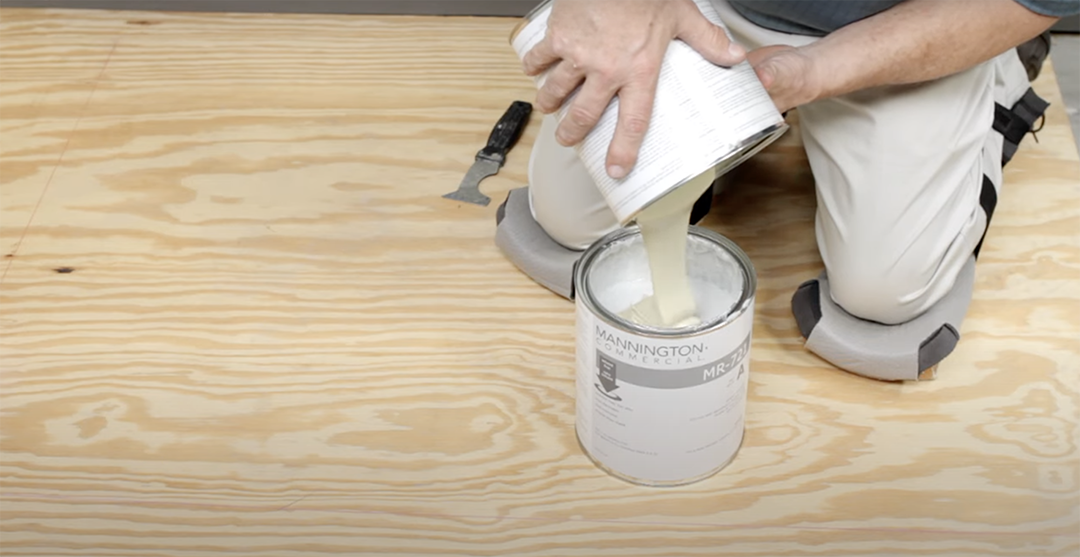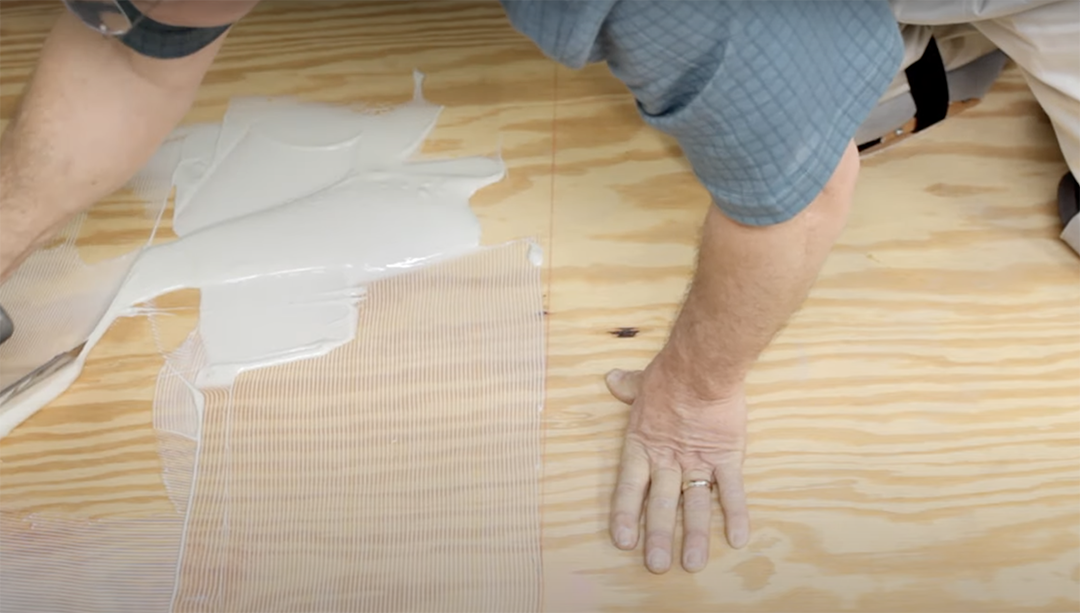Let’s talk about adhesives. It might not sound like the hottest topic, but it’s a critical component of installing a floor that will withstand long-term use and continue to perform well. I’ll break down several key factors including use case, installation and moisture limitations. Each one figures into the relevant decisions for selecting the best adhesive for the job.
Types of adhesive
Before even starting a project, you should understand the adhesive products that are available so you can make an informed choice. There are several types of adhesives and selecting the right one depends on multiple factors.
Acrylics are the standard, most used type. However, this creates a softer result that can displace if used in the wrong conditions.
Tapes and spray can be various bases, but are generally acrylic, offering a thin alternative. There also are urethane and epoxy options which are usually two-part products that dry to a harder finish state after curing than the acrylic counterpart.

Use considerations
To choose the best product for optimum performance, start by evaluating how the area will be used along with the type of flooring to be installed. Acrylics are often applied in high-traffic areas, but keep in mind that traffic could come from walking with foot traffic or it could come from rolling loads, such as dollies used to move relatively light loads or heavy equipment.
Note the difference in heavy point loads versus a heavy rolling load. A heavy point load means that the load will be stationary for an extended period of time where a heavy rolling load travels across the floor.
For situations with rolling heavier point loads, urethane or epoxy is a better option. Areas with stationary hospital beds such as patient rooms are a good example of a space where using a two-part system that sets especially hard is preferred. Otherwise, you can get indentations in the floor.
But it’s not always a one-product solution. Different spaces in the same building can have different requirements. Acrylic is fine for hallways where people walk and hospital beds are in motion or only stopped for short periods, but you might want to consider hard-set, two part adhesives for other uses in the same building.
The Moisture Factor
It sounds obvious, but moisture is a consideration in almost every aspect of selecting flooring materials. Luxury vinyl tile (LVT) and sheet vinyl are waterproof. Carpet depends on the backing, with higher moisture alternatives being porous and allowing moisture to pass through. Rubber is porous and will absorb moisture without allowing it to pass through, making it expand and contract, which can cause gaps in the installation.
The flooring adhesive is dictated in part by the type of flooring material and its moisture resistance. A tape system allows you to cover the entire back of the flooring, essentially placing an adhesive layer between the rubber and the moisture. Some type of moisture barrier is necessary if the concrete slab has a high moisture content, which opens another discussion.
The age of the slab impacts moisture. Building codes on most new construction require a moisture vapor retarder which is basically a thin layer of plastic installed between the concrete and the ground. A high moisture reading in a new slab could mean the concrete is still curing, and with time the moisture will evaporate out in the next couple of months.
With a slab that’s five to 10 years old, a high moisture reading indicates there’s a tear in the vapor retarder or one was never installed. Those cases require mitigation, but there are viable adhesive options. As examples, luxury vinyl tile (LVT) needs the right adhesive whereas carpet needs a combination of an adhesive and a backing system. The right product combination is necessary for the installation to be covered by the warranty.
Related: How Does Slab Moisture Affect Flooring?

The Right Product For The Job
The type of flooring is an obvious factor in deciding an adhesive too. The products must be compatible. Some adhesives just don’t work well with rubber; and some aren’t made for vinyl products. Sometimes it’s not that the adhesive wouldn’t work, it just could be overkill for the flooring being installed. We recommend that you always follow the manufacturer’s recommendations for adhesive with your specific flooring product and use case.
The different types of adhesives and the installation methods can get complicated, but they don’t have to be overly complex. There are wet sets and pressure sensitive adhesives. Wet sets are usually applied with a trowel, and are installed into just as the name suggests - wet. When these adhesives set, they don’t release. They cure to an hard set, meaning you cannot reposition the flooring after it sets. Drying can take as little as 24 hours, while a full cure can take up to 30 days. The primary factor is that the product will not be repositionable after drying.
Pressure sensitive adhesives take 30 minutes or so to form a tacky state, but you can reposition the flooring. That makes installing LVT with a lot of seams easier. Unlike a wet set, there’s no tendency for the adhesive to come up through the seams which requires more clean up.
Manufacturers provide recommendations for the right type of adhesive to use with a product. For example, Mannington Commercial vets all stocked adhesives.
Using something that isn’t recommended can negate the bond warranty with the flooring manufacturer, which would make addressing any failure situation complicated. Work with your product representative to ensure you find the right combination of adhesive and flooring product and follow the correct installation guidelines for optimum performance.
Would you like to learn more about moisture while earning AIA/IDCEC CEU credits?
Click below to request the CEU, Moisture: Why It’s a Hot Topic & How to Mitigate It in Flooring Installations 👇

